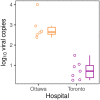The spatial and temporal distribution of SARS-CoV-2 from the built environment of COVID-19 patient rooms: A multicentre prospective study
- PMID: 36913370
- PMCID: PMC10010533
- DOI: 10.1371/journal.pone.0282489
The spatial and temporal distribution of SARS-CoV-2 from the built environment of COVID-19 patient rooms: A multicentre prospective study
Abstract
Background: SARS-CoV-2 can be detected from the built environment (e.g., floors), but it is unknown how the viral burden surrounding an infected patient changes over space and time. Characterizing these data can help advance our understanding and interpretation of surface swabs from the built environment.
Methods: We conducted a prospective study at two hospitals in Ontario, Canada between January 19, 2022 and February 11, 2022. We performed serial floor sampling for SARS-CoV-2 in rooms of patients newly hospitalized with COVID-19 in the past 48 hours. We sampled the floor twice daily until the occupant moved to another room, was discharged, or 96 hours had elapsed. Floor sampling locations included 1 metre (m) from the hospital bed, 2 m from the hospital bed, and at the room's threshold to the hallway (typically 3 to 5 m from the hospital bed). The samples were analyzed for the presence of SARS-CoV-2 using quantitative reverse transcriptase polymerase chain reaction (RT-qPCR). We calculated the sensitivity of detecting SARS-CoV-2 in a patient with COVID-19, and we evaluated how the percentage of positive swabs and the cycle threshold of the swabs changed over time. We also compared the cycle threshold between the two hospitals.
Results: Over the 6-week study period we collected 164 floor swabs from the rooms of 13 patients. The overall percentage of swabs positive for SARS-CoV-2 was 93% and the median cycle threshold was 33.4 (interquartile range [IQR]: 30.8, 37.2). On day 0 of swabbing the percentage of swabs positive for SARS-CoV-2 was 88% and the median cycle threshold was 33.6 (IQR: 31.8, 38.2) compared to swabs performed on day 2 or later where the percentage of swabs positive for SARS-CoV-2 was 98% and the cycle threshold was 33.2 (IQR: 30.6, 35.6). We found that viral detection did not change with increasing time (since the first sample collection) over the sampling period, Odds Ratio (OR) 1.65 per day (95% CI 0.68, 4.02; p = 0.27). Similarly, viral detection did not change with increasing distance from the patient's bed (1 m, 2 m, or 3 m), OR 0.85 per metre (95% CI 0.38, 1.88; p = 0.69). The cycle threshold was lower (i.e., more virus) in The Ottawa Hospital (median quantification cycle [Cq] 30.8) where floors were cleaned once daily compared to the Toronto hospital (median Cq 37.2) where floors were cleaned twice daily.
Conclusions: We were able to detect SARS-CoV-2 on the floors in rooms of patients with COVID-19. The viral burden did not vary over time or by distance from the patient's bed. These results suggest floor swabbing for the detection of SARS-CoV-2 in a built environment such as a hospital room is both accurate and robust to variation in sampling location and duration of occupancy.
Copyright: © 2023 Fralick et al. This is an open access article distributed under the terms of the Creative Commons Attribution License, which permits unrestricted use, distribution, and reproduction in any medium, provided the original author and source are credited.
Conflict of interest statement
I have read the journal’s policy and the authors of this manuscript have the following competing interests: Michael Fralick is a consultant for ProofDx, a start-up company that has created a point-of-care device for COVID-19 using CRISPR.
Figures



References
-
- Hinz A, Xing L, Doukhanine E, et al. SARS-CoV-2 detection from the built environment and wastewater and its use for hospital surveillance. Facets. 2022;7(1):82–97.
Publication types
MeSH terms
Grants and funding
LinkOut - more resources
Full Text Sources
Medical
Miscellaneous

